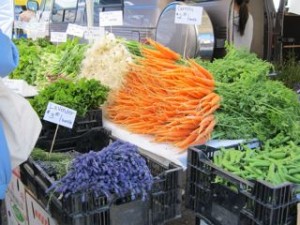Seattle’s Abundance of Farmer’s Markets – Is it too much?
I read a really interesting article in Seattle Magazine by Rebekah Denn about the increasing number of Farmer’s Markets in the Seattle area and the impact it is having on the Neighborhood Farmer’s Market Alliance. According to the article there is a total of 18 Farmer’s Markets in Seattle this summer. If there are too many Farmer’s Markets will Seattle and King County farmers be able to keep the supply and demand in balance? Chris Curtis thinks not – and how can you ignore what she has accomplished with the Alliance since the University District Farmer’s Market started in 1993? To me, this highlights an ongoing discussion about who is allowed to sell at the Neighborhood Farmer’s Market Alliance markets and the catch-all nature of “Seattle’s Outdoor European-Style Markets“.
In a recent post on the Quirky Gourmet blog, Devra mentions a “renegade vendor” at the Columbia City Farmer’s Market who has found a clever way to avoid complying with the Neighborhood Farmer’s Market Alliance requirements for vendors. Some of you may remember a post I wrote about the Ballard Farmer’s Market where I was highlighting the difference in the rules for being a vendor at an Alliance market, versus being a vendor at some of Seattle’s other outdoor markets. To sell at a market that is part of the Alliance you must be a Washington state farmer or small food business selling your own product. Markets that are part of the Alliance do not allow vendors that sell crafts, imports, or second hand goods. The people who produce or grow the food must also be the ones who sell at the market. My guess is that the guy who is selling popcorn on park property did not grow the corn. According to the post he had applied to be part of the Columbia City Market but was turned down.
As a shopper, maybe I want as many buying options as possible at any market, but if it’s more important to me that farmers to keep bringing local food to my neighborhood, then I want them to have a market where they are guaranteed profitability. If that means eliminating the non-local food items from the market that is okay with me. Why does the Alliance dedicate the outdoor market to farmers and producers only? Here’s the math.
If the consumer brings $30.00 to spend at the market and spends $15.00 on the silver earrings at the stand next to the producer, that further reduces the amount of money the consumer will spend on produce or food. It also lessens the possibility that the producer will sell all of his/her product or get a good financial return for participating in the market. Another problem is that the producer cannot bring his/her perishable goods back again the following week but the jewelry seller can. While it’s true that having a variety of vendors may attract a bigger crowd, it does not necessarily mean that the market will be more profitable for the farmers and producers. Make sense?
